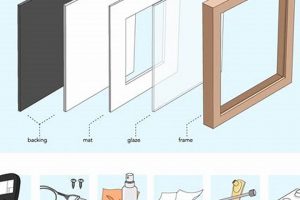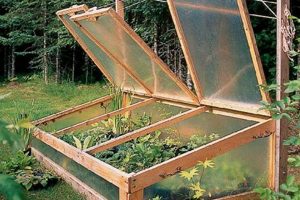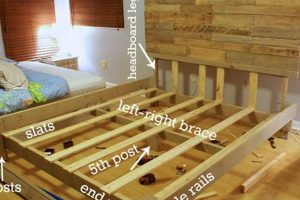A structure crafted at home for stretching fabric taut, creating a stable surface essential for the process of adhering yarn to create pile rugs, wall hangings, and other textile art pieces, defines the subject. It serves as the foundation upon which the tufting gun operates, allowing for consistent and controlled yarn penetration. For instance, individuals looking to create customized rugs often begin by building this necessary apparatus.
Such a construction allows for cost-effective entry into the tufting craft. It eliminates the need for expensive, professionally manufactured equipment, making the art form accessible to a wider audience. Furthermore, the creation process fosters a deeper understanding of the tools and techniques involved, potentially leading to more innovative approaches. Historically, similar frames were used in traditional rug making, albeit with different methods of yarn application. The modern adaptation allows crafters a way to produce items according to their own desired specifications and dimensions.
The construction of a suitable apparatus involves consideration of materials, dimensions, and tensioning mechanisms. The subsequent sections will delve into the various design approaches, material choices, and techniques required for successfully building this tool.
Essential Considerations for Frame Construction
The following insights are crucial for ensuring a durable and effective fabric support structure for tufting projects.
Tip 1: Material Selection: Employ hardwoods such as maple or birch for the frame’s primary structure. These materials offer superior strength and resistance to warping under fabric tension compared to softwoods. Consider metal framing for larger projects requiring greater stability.
Tip 2: Joint Reinforcement: Secure frame joints with screws, glue, and corner brackets. This combination prevents loosening or separation under the constant stress of taut fabric, enhancing the lifespan of the equipment.
Tip 3: Fabric Tensioning System: Implement a robust method for stretching and securing the fabric. Consider using gripper strips, clamps, or a lacing system. The chosen method must provide uniform tension across the entire surface to prevent fabric sagging during tufting.
Tip 4: Frame Dimensions: Carefully determine the appropriate dimensions based on the project size and workspace. A larger frame allows for bigger rugs but demands greater structural integrity. Optimize size for maneuverability and ease of use.
Tip 5: Surface Smoothness: Ensure all frame surfaces that come into contact with the fabric are smooth and free of splinters. Sanding and sealing the wood prevents snagging or damage to the fabric during use.
Tip 6: Frame Height and Angle: Consider the ergonomic aspects of the setup. The frame height should allow for comfortable operation of the tufting gun, and an angled frame can reduce strain during extended use.
Tip 7: Leveling and Stability: Confirm the frame is perfectly level and stable. Uneven surfaces can lead to uneven tufting and potential damage to the equipment or the project. Adjustable feet can aid in achieving a level working surface.
Adhering to these construction guidelines is vital to constructing a sturdy and dependable foundation that enhances the tufting workflow and maximizes the longevity of the constructed apparatus. These tips will provide stability and a long-lasting tool.
The subsequent section will cover the selection and application of suitable fabrics.
1. Structural Integrity
Structural integrity is paramount to the functionality of a self-constructed fabric support. The capacity of the frame to resist deformation and maintain its intended shape under the sustained tension applied by the tufting fabric directly influences the consistency and quality of the resulting textile piece. Insufficient structural strength results in frame warping or joint failure, leading to uneven fabric tension and ultimately, irregularities in pile height and pattern distortion. For instance, a frame constructed from thin, unsupported wood members may bow inward under tension, causing the fabric to slacken in the center. This slackness hinders the uniform penetration of the tufting gun, producing an uneven surface.
Conversely, a frame with adequately reinforced corners, substantial material thickness, and strategically placed support structures effectively distributes the applied tension. This stability ensures the fabric remains consistently taut across the entire working area, permitting the creation of intricate designs without concerns of distortion. Consider a large-scale rug project: the frame must not only support the initial fabric tension but also the added weight of the accumulating yarn. A frame designed with a robust supporting network minimizes any deflection, allowing the craftsman to focus on the design execution rather than constantly readjusting the fabric tension.
The understanding of structural mechanics and material properties is, therefore, crucial for the successful development of this specialized framework. In summary, structural integrity underpins the functional effectiveness of this apparatus. Its absence compromises the accuracy and consistency of the tufting process, while its presence fosters a stable and reliable environment for creating high-quality textile art. Prioritizing the frame’s structural soundness ensures a worthwhile investment of time and materials, leading to superior craftsmanship and project outcomes.
2. Tensioning Mechanism
The means by which fabric is secured and stretched taut within a constructed frame represents a critical component affecting both the ease of use and the quality of the final tufted product. Adequate and consistent tension is necessary for the precise application of yarn and the creation of even pile heights, therefore the choice and implementation of the tensioning mechanism are of utmost importance.
- Gripper Strips
Gripper strips, consisting of rows of angled pins or tacks, firmly grip the fabric along the frame’s perimeter. They provide a secure hold that prevents slippage during the tufting process. The effectiveness of gripper strips is dependent on the type of fabric being used; heavier, more densely woven fabrics will be held more effectively. The disadvantage is the potential for fabric damage upon removal.
- Clamps
Clamps, such as spring clamps or woodworking clamps, can be used to secure the fabric to the frame. Clamps offer adjustability, allowing for incremental tension adjustments as needed during the tufting process. The choice of clamp must consider the potential for fabric damage or slippage if the clamping force is insufficient. Even pressure distribution from the clamp is key to preventing fabric distortion during the process.
- Lacing Systems
A lacing system involves threading cord or rope through eyelets or holes placed along the fabric edge and around the frame. This method allows for distributing tension evenly across the entire fabric surface. The degree of tension can be finely tuned by adjusting the cord tightness. This system requires careful planning and execution to ensure uniform tension and prevent fabric tearing around the eyelets.
- Stretching Frames
In some designs, the frame itself may incorporate mechanisms for physically stretching the fabric. This can involve adjustable side rails or corner tensioners that allow the user to increase or decrease the fabric tension. Such systems offer precise control over fabric tension, but require more complex construction and may be more expensive to implement.
The selection and integration of an appropriate tensioning mechanism is vital for a functional and efficient tufting process. Proper implementation of any of these systems will translate to the ability to produce high-quality, dimensionally accurate tufted textiles. The chosen mechanism should balance ease of use, fabric compatibility, and the degree of tension control required for the specific project. A suitable system is the cornerstone of a good frame which allows good tufting results.
3. Dimensional Accuracy
Dimensional accuracy, in the context of a self-constructed fabric support, is a crucial factor governing the final dimensions and geometry of the tufted article. Precise measurements and adherence to design specifications during frame construction directly translate to the accuracy of the finished rug, wall hanging, or textile art piece.
- Frame Squareness and Rectangularity
The frame must maintain perfect squareness or rectangularity, depending on the intended project shape. Deviation from these geometric forms results in skewed or distorted final products. For instance, if a frame intended for a rectangular rug is not perfectly rectangular, the rug’s edges will not be straight, and its corners will not be at right angles. This error propagates throughout the tufting process, becoming increasingly noticeable as the design progresses.
- Internal Dimensions and Fabric Allowance
The internal dimensions of the frame dictate the maximum tufting area. Careful consideration must be given to fabric allowance beyond these internal dimensions for secure attachment to the frame. Insufficient allowance results in difficulty securing the fabric, while excessive allowance can complicate the tensioning process. For instance, a frame with internal dimensions of 4ft x 6ft requires additional fabric beyond these measurements to accommodate gripper strips or lacing systems along all edges.
- Parallelism of Frame Members
Parallelism of opposing frame members is essential for maintaining uniform fabric tension. Non-parallel members introduce varying tension across the fabric surface, leading to inconsistencies in pile height and pattern distortion. For example, if the top and bottom frame members are not perfectly parallel, the fabric will be tighter on one side than the other, resulting in an uneven tufted surface.
- Consistency in Frame Thickness
The thickness of the frame material itself must be consistent around its perimeter. Variations in frame thickness can affect the fabric tensioning mechanism and the overall stability of the structure. For instance, if the frame material is thicker in one area, the fabric might not sit flush, leading to localized tension differences and potential difficulty in maneuvering the tufting gun.
These aspects highlight how dimensional inaccuracies in frame construction directly impact the accuracy and overall quality of the tufted product. Careful attention to detail and precise measurements during the frame’s construction are therefore imperative for achieving intended results and producing professional-grade textile art.
4. Material Suitability
The selection of appropriate materials directly governs the durability, stability, and overall performance of a self-constructed fabric support. This factor is not merely a matter of aesthetic preference; it fundamentally dictates the frame’s capacity to withstand the stresses inherent in the tufting process and maintain dimensional integrity over extended use. A poorly chosen material can lead to frame warping, joint failure, and ultimately, compromised tufting results. For example, using low-density particleboard for the frame’s primary structure risks catastrophic failure under the sustained tension applied by the stretched fabric. Conversely, a properly selected material, such as hardwood, provides the necessary rigidity and resistance to deformation, ensuring a stable and reliable tufting platform.
The implications of material choice extend beyond structural integrity. The surface finish of the chosen material also affects fabric handling and ease of use. A rough or splintered surface can snag the fabric, hindering smooth movement during tufting and potentially damaging delicate textiles. Therefore, materials must be chosen not only for their strength but also for their ability to be finished to a smooth, snag-free surface. The selection process should also consider the long-term effects of environmental factors, such as humidity and temperature fluctuations, on the chosen material. For example, certain wood species are more prone to warping in humid conditions, necessitating careful sealing or alternative material choices.
Ultimately, informed material selection is a critical step in constructing a functional and long-lasting fabric support. Ignoring this aspect compromises the investment of time and resources, potentially leading to substandard results and early frame failure. By carefully considering the material’s strength, stability, surface properties, and environmental resistance, one can ensure the construction of a durable and reliable tufting apparatus capable of producing high-quality textile art. The challenge lies in balancing cost-effectiveness with the performance requirements of the project, leading to a potentially iterative selection process based on both theoretical understanding and practical experience.
5. Ergonomic Design
Ergonomic design principles, when applied to the construction of a self-made fabric support, directly influence user comfort, reduce physical strain, and enhance productivity. A poorly designed frame can lead to musculoskeletal discomfort, particularly in the back, shoulders, and wrists, due to prolonged awkward postures and repetitive motions involved in tufting. The height of the frame, the angle of the working surface, and the accessibility of materials are all critical ergonomic considerations. For example, a frame that is too low necessitates constant bending, increasing the risk of back pain, while a frame that is too high forces the user to raise their arms excessively, leading to shoulder and neck strain. A frame positioned at an appropriate height allows for a neutral spine posture and minimizes upper body strain.
Further ergonomic considerations include the placement of tools and materials within easy reach, reducing the need for excessive reaching or twisting. Incorporating adjustable features, such as height-adjustable legs or a tilting working surface, accommodates individual user preferences and varying project requirements. The surface finish and edge treatment of the frame also contribute to user comfort. Sharp edges or rough surfaces can cause discomfort or injury during prolonged use. A smooth, rounded edge reduces the risk of pressure points and friction. The design should consider the physical space available and the workflow of the tufting process. A well-organized workspace minimizes unnecessary movements and reduces the risk of accidents. For instance, incorporating a built-in yarn storage system keeps materials readily accessible and prevents tripping hazards.
In summary, the integration of ergonomic design principles into the fabrication of a do-it-yourself tufting apparatus is essential for promoting user well-being, preventing physical strain, and maximizing efficiency. While the primary function of the frame is to support the fabric, its design must prioritize the comfort and safety of the user. Addressing ergonomic factors enhances the overall tufting experience, leading to improved productivity and reduced risk of work-related injuries. The application of these principles transforms the frame from a simple structural element into a user-centered tool, contributing to a more sustainable and enjoyable crafting process.
Frequently Asked Questions About Fabric Support Structures
The following addresses common inquiries regarding the construction and utilization of fabric support structures for tufting projects. These questions aim to clarify important aspects and provide guidance for successful implementation.
Question 1: What type of wood is best suited for constructing a durable fabric support?
Hardwoods, such as maple or birch, are generally preferred due to their inherent strength and resistance to warping. Softwoods, while less expensive, may not provide adequate stability under sustained tension. The selection should balance cost considerations with the long-term structural integrity requirements.
Question 2: How does one ensure that the fabric is evenly tensioned across the apparatus?
Employing a tensioning system that distributes force uniformly is crucial. This can be achieved through gripper strips meticulously aligned, lacing systems with evenly spaced eyelets, or clamps applied at regular intervals. Regular monitoring and adjustment of tension is advisable throughout the tufting process.
Question 3: What are the recommended dimensions for a fabric support intended for a large-scale rug project?
The dimensions are dictated by the desired size of the final product plus sufficient allowance for fabric attachment and tensioning. Adequate structural support, including cross-bracing, is essential for larger frames to prevent sagging or warping. A common starting point is adding at least 6 inches on each side of the intended rug dimensions for securing the fabric.
Question 4: How can potential damage to the fabric from the tensioning mechanism be minimized?
Using padding or protective layers between the fabric and the tensioning device can mitigate the risk of tears or abrasions. Additionally, avoiding excessive tension and regularly inspecting the fabric for signs of stress can prevent irreversible damage.
Question 5: What methods exist for ensuring the fabric support remains stable and level during tufting?
Constructing a robust base and incorporating adjustable feet allow for leveling the frame on uneven surfaces. Securing the apparatus to a stable workbench or floor can further enhance stability and prevent unwanted movement during operation.
Question 6: How does the fabric support’s angle influence the tufting process, and what is an ideal angle?
An angled frame can improve ergonomics and visibility, reducing strain on the back and neck. The optimal angle varies depending on individual preferences and project requirements; however, a tilt between 15 and 30 degrees is often recommended.
These answers provide fundamental knowledge for constructing and utilizing a fabric support for tufting. Further research and experimentation may be necessary to optimize the setup for specific projects and individual needs.
The subsequent section will explore various design modifications and advanced techniques.
Conclusion
The preceding discussion has illuminated the multifaceted considerations involved in the creation of a functional and efficient fabric support structure. From material selection and structural integrity to tensioning mechanisms and ergonomic design, each element contributes to the overall success of the tufting process. A well-executed design streamlines workflow, promotes consistent results, and ultimately enhances the quality of the produced textile art.
By understanding and implementing these principles, artisans can create customized setups tailored to their specific needs and project requirements. The construction of this apparatus is not merely a means to an end but a critical step in mastering the art of tufting. As such, continued exploration, experimentation, and refinement are encouraged to unlock the full potential of this craft and foster innovation within the textile arts community.







